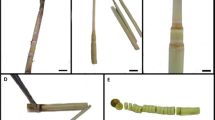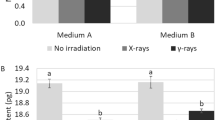Abstract
Efficient plant regeneration system from cell suspension cultures was established in D. acicularis (2n=90) by monitoring ploidy level and visual selection of the cultures. The ploidy level of the cell cultures closely related to the shoot regeneration ability. The cell lines comprising original ploidy levels (2C+4C cells corresponding to DNA contents of G1 and G2 cells of diploid plant, respectively) showed high regeneration ability, whereas those containing the cells with 8C or higher DNA C-values showed low or no regeneration ability. The highly regenerable cell lines thus selected consisted of compact cell clumps with yellowish color and relatively moderate growth, suggesting that it is possible to select visually the highly regenerable cell lines with the original ploidy level. All the regenerated plantlets from the highly regenerable cell cultures exhibited normal phenotypes and no variations in ploidy level were observed by flow cytometry (FCM) analysis.


Similar content being viewed by others
Abbreviations
- Centrophenoxine :
-
4-Chlorophenoxyacetic acid 2-dime-thylamino ethyl ester.
- DAPI :
-
4′, 6-Diamino-2-phenylindole dihydrochloride.
- 2,4-D :
-
2,4-Dichlorophenoxyacetic acid.
- FCM :
-
Flow cytometry.
- IAA :
-
Indole-3-acetic acid.
- NAA :
-
α-Naphthaleneacetic acid.
- PGR :
-
Plant growth regulator.
- Picloram :
-
4-Amino-3,5,6-trichloropicolinic acid
References
Aziz P, Supaibulwatana K, Mii M, Koba T (1999) Cytological and RAPD (random amplified polymorphic DNA) analysis of somaclonal variation in Easter lily (Lilium longiflorum Thunb.). Plant Biotechnol 16:247–250
D'Amato F (1985) Cytogenetics of plant cell and tissue cultures and their regenerates. CRC Crit Rev Plant Sci 3:73–112
Davey MR, Anthony P, Power JB, Lowe KC (2005) Plant protoplasts: status and biotechnological perspectives. Biotechnol Adv 23:131–171
Estopà M, Marfà V, Melé E, Messeguer J (2001) Study of different antibiotic combinations for use in the elimination of Agrobacterium with kanamycin selection in carnation. Plant Cell Tissue Organ Cult 65:211–220
Gilissen LJW, Van Staveren MJ, Hakkert JC, Smulders MJM, Verhoeven HA, Creemers-Molenaar J (1994) The competence of cells for cell division and regeneration in tobacco explants depends on cellular location, cell cycle phase, and ploidy level. Plant Sci 103:81–91
Khayat E (1990) Biotechnological approaches to breeding and cultivation of ornamental crop plants. Biotechnol Adv 8:347–357
Kumar PS, Mathur VL (2004) Chromosomal instability in callus culture of Pisum sativum. Plant Cell Tissue Organ Cult 78:267–271
Libbenga KR, Torrey JG (1973) Hormone-induced endoreduplication prior to mitosis in cultured pea root cortex cells. Am J Bot 60:293–299
Liscum E, Hangarter RP (1991) Manipulation of ploidy level in cultured haploid Petunia tissue by phytohormone treatments. J Plant Physiol 138:33–38
Lu C, Chandler SF (1995) Genetic transformation of Dianthus caryophyllus (Carnation). In: Bajaj YPS (ed) Biotechnology in agriculture and forestry, vol. 34. Springer-Verlag, Berlin-Heidelberg, Germany, pp 156–170
Lu CY, Nugent G, Wardley-Richardson T, Chandler SF, Young R, Dalling MJ (1991) Agrobacterium-mediated transformation of carnation (Dianthus caryophyllus L.). Biotechnology 9:864–868
Mii M, Buiatti M, Gimelli F (1990) Carnation. In: Ammirato PV, Evans DA, Sharp WR, Bajaj YPS (eds) Handbook of plant cell culture, vol. 5. McGraw-Hill, New York, pp 284–318
Mishiba K, Okamoto T, Mii M (2001) Increasing ploidy level in cell suspension cultures of Doritaenopsis by exogenous application of 2,4-dichlorophenoxyacetic acid. Physiol Plant 112:142–148
Murashige T, Skoog F (1962) A revised medium for rapid growth and bioassays with tobacco tissue cultures. Physiol Plant 15:473–497
Nakano M, Mii M (1992) Protoplast culture and plant regeneration of several species in the genus Dianthus. Plant Cell Rep 11:225–228
Nimura M, Kato J, Mii M, Morioka K (2003) Unilateral compatibility and genotypic difference in crossability in interspecific hybridization between Dianthus caryophyllus L. and Dianthus japonicus Thunb. Theor Appl Genet 106:1164–1170
Nontaswatsri C, Fukai S, Goi M (2004) Revised cocultivation conditions produce effective Agrobacterium-mediated genetic transformation of carnation (Dianthus caryophyllus L.). Plant Sci 166:59–68
Ochatt SJ, Mousset-Déclas C, Rancillac M (2000) Fertile pea plants regenerate from protoplasts when calluses have not undergone endoreduplication. Plant Sci 156:177–183
Onozaki T, Yamaguchi T, Himeno M (1998) Introduction of bacterial wilt (Pseudomonas caryophylli) resistance in Dianthus wild species to carnation. Acta Hortic 454:127–132
Onozaki T, Yamaguchi T, Himeno M, Ikeda H (1999) Evaluation of wild Dianthus accessions for resistance to bacterial wilt (Pseudomonas caryophylli). J Jpn Soc Hortic Sci 68:974–978
Phillips RL, Kaeppler SM, Olhoft P (1994) Genetic instability of plant tissue cultures: breakdown of normal controls. Proc Natl Acad Sci USA 91:5222–5226
Rohweder H (1934) Beiträge zur Systematik und Phylogenie des Genus Dianthus unter Berücksichtigung der karyologischen Verhältnisse. Botanische Jabrbücher für Systematik, Pflanzengeographie 66:249–368
Sarreb DA, Ładyżyński M, Malepszy S (2002) Comparison of triploid and diploid cucumber in long-term liquid cultures. Plant Cell Tissue Organ Cult 71:231–235
Singh RJ (1986) Chromosomal variation in immature embryo derived calluses of barley (Hordeum vulgare L.). Theor Appl Genet 72:710–716
Supaibulwatana K, Mii M (1998) Induction of meristematic nodular calli from various explants of Lilium spp. and long term stability in plant regeneration ability and ploidy level of the calli. Plant Biotechnol 15:95–102
Van Altvorst AC, Riksen T, Koehorst H, Dons HJM (1995a) Transgenic carnations obtained by Agrobacterium tumefaciens-mediated transformation of leaf explants. Transgenic Res 4:105–113
Van Altvorst AC, Riksen T, Koehorst H, Dons H (1995b) Shoot regeneration and Agrobacterium-mediated transformation of carnation. Acta Hortic 420:92–94
Van Altvorst AC, Koehorst H, De Jong J, Dons HJM (1996) Transgenic carnation plants obtained by Agrobacterium tumefaciens-mediated transformation of petal explants. Plant Cell Tissue Organ Cult 45:169–173
Zhang DL, Li KQ, Gu W, Hao LF (1987) Chromosome aberration and ploidy equilibrium of Vicia faba in tissue culture. Theor Appl Genet 75:132–137
Zhang S, Zhu L-H, Li X-Y, Ahlman A, Welander M (2005) Infection by Agrobacterium tumefaciens increased the resistance of leaf explants to selective agents in carnation (Dianthus caryophyllus L. and D. chinensis). Plant Sci 168:137–144
Zuker A, Chang P-FL, Ahroni A, Cheah K, Woodson WR, Bressan RA, Watad AA, Hasegawa PM, Vainstein A (1995) Transformation of carnation by microprojectile bombardment. Sci Hortic 64:177–185
Zuker A, Ahroni A, Tzfira T, Ben-Meir H, Vainstein A (1999) Wounding by bombardment yields highly efficient Agrobacterium-mediated transformation of carnation (Dianthus caryophyllus L.). Mol Breed 5:367–375
Zuker A, Tzfira T, Scovel G, Ovadis M, Shklarman E, Itzhaki H, Vainstein A (2001) RolC-transgenic carnation with improved horticultural traits: quantitative and qualitative analyses of greenhouse-grown plants. J Am Soc Hortic Sci 126:13–18
Author information
Authors and Affiliations
Corresponding author
Additional information
Communicated by K.K. Kamo
Rights and permissions
About this article
Cite this article
Shiba, T., Mii, M. Visual selection and maintenance of the cell lines with high plant regeneration ability and low ploidy level in Dianthus acicularis by monitoring with flow cytometry analysis. Plant Cell Rep 24, 572–580 (2005). https://doi.org/10.1007/s00299-005-0011-7
Received:
Revised:
Accepted:
Published:
Issue Date:
DOI: https://doi.org/10.1007/s00299-005-0011-7




